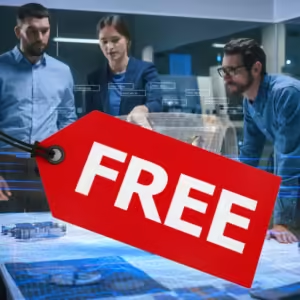
Google DeepMinds AI teaches robot to tie shoelaces handle tasks
DeepMind has taken a significant leap in robotic capabilities with its new AI systems. These systems enable robots to tackle complex, dexterous tasks with remarkable precision and efficiency.
This exciting development demonstrates the potential of AI in enhancing robotic functions, showing promise in both simulated and real-world environments.
Enhanced Robotic Learning
Until now, most sophisticated AI robots have been equipped to use one arm to pick up and position objects. DeepMind’s ALOHA Unleashed builds upon the ALOHA 2 platform, pushing the boundaries of robotic dexterity with bi-arm handling.
Originally developed from a low-cost open-source hardware system for bimanual teleoperation at Stanford University, ALOHA 2 features two teleoperable hands. This allows for advanced training and data collection, enabling robots to learn new tasks with fewer demonstrations.
The ergonomic design and enhanced learning process of ALOHA Unleashed take robotic capabilities to new heights. By remotely controlling the robot to perform complex tasks, such as tying shoelaces and hanging t-shirts, high-quality demonstration data is gathered.
Dexterous AI Breakthrough
Controlling a dexterous robotic hand is a complex challenge, especially as more fingers, joints, and sensors are added. DemoStart tackles this by using reinforcement learning to help robots develop dexterous abilities in simulations. This method is beneficial for robots with intricate features like multi-fingered hands.
DemoStart begins by learning from simple tasks and progressively moves to more difficult ones, mastering each task step by step.
Compared to traditional learning methods from real-world examples, DemoStart requires 100 times fewer simulated demonstrations to achieve the same level of proficiency.
[twitter-embed-display twitter_url=’https://twitter.com/GoogleDeepMind/status/1834232555396018464′]
Real-World Applications
The DEX-EE three-fingered robotic hand, developed by Shadow Robot in collaboration with the Google DeepMind team, exemplifies the practical applications of these AI systems.
In simulations, DEX-EE achieved a success rate of over 98 percent in tasks like cube reorientation and tightening nuts. In real-world tests, similar tasks saw a success rate of up to 97 percent.
DemoStart’s reinforcement learning, combined with a few demonstrations, creates a curriculum that effectively bridges the gap between simulations and real-world performance.
Advanced Ergonomic Design
The latest system from DeepMind includes an improved ergonomic design and an enhanced learning process. Demonstrations are achieved by remotely controlling the robot, which performs tasks such as tying shoelaces and hanging t-shirts.
By learning from high-quality demonstration data, robots can perform these tasks independently, showcasing a significant step forward in robotic learning.
Simulation to Real-World Performance
Using MuJoCo, an open-source physics simulator, DemoStart’s learned behaviors can be transferred to physical robots with minimal adjustments. Techniques like domain randomization can close the sim-to-real gap.
This method saves both time and costs by reducing the need for physical trials. The challenge lies in designing simulations that translate successfully into real-world performance.
Future Implications
Google DeepMind’s advancements in AI-powered robotic dexterity could revolutionize various fields, from home assistance to industrial applications. One day, AI robots may help people with an array of tasks at home, in workplaces, and beyond.
“Dexterity research, including the efficient and general learning approaches we’ve described today, will help make that future possible,” said the DeepMind team.
Continued Research and Development
There is still much to be done before robots achieve human-level dexterity. However, the progress made through systems like ALOHA Unleashed and DemoStart is promising.
The ongoing research and development in this field pave the way for creating more helpful, dexterous robots. Future advancements will likely see these robots performing a broader range of tasks with even greater efficiency and precision.
The strides made by DeepMind in robotic dexterity mark a pivotal moment in AI research and application.
With continued development, robots could soon handle a vast array of complex tasks, changing the way we interact with technology daily.
Source: Interestingengineering – Youtube – Twitter
- September 14, 2024
- 453
- Engineering
- 0 comment







Add Comment